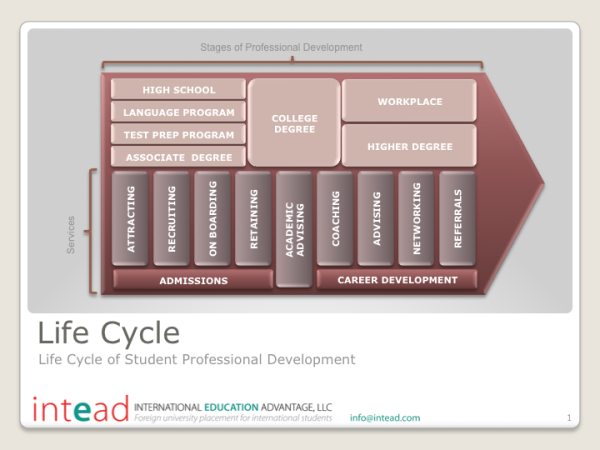For all those students of economics, yes PPP can stand for purchasing power parity, but I would like to use PPP as President and Parent Perspective. Why do I want to talk about that perspective?
Presidents of universities and parents of students are the two groups that should have the most holistic view of the education process for a student. Remember we all have different perspectives, depending on our role and responsibility at the time.
We will advocate a more holistic approach to international education marketing to help parents and students find the right match. This approach includes a broader life cycle of education, as displayed in the graph below. We want to shift institutions, parents and students to look at the longer term perspective.
Success in education requires a holistic and long-term view. We have immediate indicators such as first year retention rate and medium-term benchmarks such as graduation rates and placement after graduation. These are critical benchmarks and metrics for institutions, programs and the individual. However, success of education shows itself over a lifetime and depends on the individual as much as the changes of the enviroment. Predictions about future job prospects are tenous at best. Who would have predicted 5 or 10 years ago an explosion for the need of mobile app developers without the existence of the iPhone?
Let me shift to the focus on what institutions can do for domestic and international students. I will emphasize the gaps from our perspective in the international student enrollment area. In international student recruitment, we are focusing too strongly on two aspects:
-
Diversity and student quality
-
Tuition revenue
We all play distinct roles in our respective function at an academic institution:
-
Admissions officer have to be focused on the "input" into the academic institution. Input defined as recruiting the most balanced, best qualified, most diverse and in most instances highest tuition paying student body. We have to keep in mind that only 10% of universites select less than half of their student applicants.
-
Student services staff is focused on on-going student success and administrative requirements
-
Academic teaching staff is focused on teaching, research and of course other administrative functions
-
Career services prepares students for the job selection process, coaches and places the greatest number of students
I chose to ignore alumni relations for this discussion, not because it's not an important function but it is less focused on the educational input and outcomes, but more on long-term financial stability and opportunity of the institution.
The President and other senior staff, based on their position definition, are looking at the process holisticly. The university cannot attract future students unless it delivers a quality educational experience and teaching as well as successful professional placement of students. Ultimately, building and preserving the reputation of the university brand, leading to a supportive body of alumni are the goals.
Parents ought to have the same perspective for their child: it is about the correct fit of a university leading to a successful and holistic educational experience, developing a well-adjusted and prepared individual who can succeed in a professional environment and life-long learning.
From our experience, institutions need to provide guidance and insight to parents domestically and even more so, internationally, on this life cycle.
For international students, parents and students are almost completely focused on the admission part --what's the highest ranked university I can enter and afford? They tend to think that the rest of their experience and future will be taken care of by entering the highest ranking school. Yes, brand matters in the academic and professional world. University brands reflect past success. There are other factors to consider besides ranking. For example, if you are a student from China, you may be much better off in a university with a more diverse group of students, encouraging and engaging you to integrate as opposed to staying within your comfort zone of Chinese fellow students. Strong mentoring or career services and extensive and engaged alumni in your future professional area can be much more decisive factors of success than the ranking from US News & World Report.
The challenge for admissions officers is how to convey that holistic perspective and make it relevant to parents and students during the university selection process. Furthermore, let's make sure that colleges and universities will live up to the more holistic and broader perspective in their service for international students.

===========================================================


